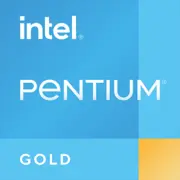Intel Pentium Gold 8500

Intel Pentium Gold 8500: Budget Processor for Everyday Tasks. Full Review
March 2025
Modern entry-level laptops are increasingly impressing with their performance. One such example is the Intel Pentium Gold 8500, which, despite its modest price, offers a 12th-generation (Alder Lake) architecture and a balance between energy efficiency and speed. Let's explore who this chip is suitable for, how it handles tasks, and what compromises must be made.
1. Architecture and Manufacturing Process: Hybrid Approach for Budget Devices
Cores, Threads, and Frequencies
The Pentium Gold 8500 is built on a hybrid Alder Lake architecture, but in a simplified configuration:
- 5 cores: 1 Performance (P-core) with Hyper-Threading support (2 threads) + 4 Energy-efficient (E-core) without multithreading.
- 6 threads: 2 from P-core + 4 from E-core.
- Base frequency: 1.8 GHz (P-core), 1.4 GHz (E-core).
- Max Turbo frequency: up to 4.4 GHz (only P-core).
The hybrid architecture allows for task distribution: P-core handles single-threaded loads (e.g., browser), while E-core manages background processes (updates, music streaming).
Integrated Graphics
The integrated GPU is Intel UHD Graphics for the 12th generation (Xe-LP, 48 EU). This is 33% fewer EUs than in Iris Xe (96 EU), but it is sufficient for basic tasks:
- Supports 4K@60 Hz via HDMI 2.0.
- Decodes AV1 and HEVC video formats.
- Modest gaming: 30-40 FPS in CS:GO on low settings (720p).
2. TDP and Power Consumption: Balance between Power and Battery Life
The processor is rated for a TDP of 15 W, which is typical for ultrabooks and thin laptops. In turbo mode, power consumption can briefly reach 25 W, but budget model cooling systems are rarely designed for sustained loads.
Thermal output:
- During office work, the temperature stays within 45-60°C.
- In stress tests (e.g., rendering), it can heat up to 85°C with throttling (frequency reduction).
3. Performance: Tests in Real Scenarios
Office and Multimedia
- Geekbench 6: 1284 (Single-Core), 2111 (Multi-Core). For comparison, the AMD Ryzen 3 7320U scores ~1200/3200. The Pentium is stronger in single-threaded tasks but weaker in multi-threaded ones.
- Microsoft Office, browser (20 tabs): operates without lags.
- Video editing: rendering a 1080p video in DaVinci Resolve takes 2-3 minutes (compared to 1 minute for Core i5-1235U).
Gaming
- Light games: League of Legends (60 FPS on medium), Minecraft (45-50 FPS).
- Heavy projects: Cyberpunk 2077 even on minimum settings gives 15-20 FPS — this is not a gaming processor.
Turbo Boost Mode
The P-core boosts to 4.4 GHz, but only for 10-15 seconds under load. For example, when opening a “heavy” Excel file or launching Photoshop.
4. Use Cases: Who is the Pentium Gold 8500 Designed For?
- Students: working with texts, presentations, online courses.
- Office workers: Excel, email, video conferences.
- Home users: surfing, streaming Netflix, casual gaming.
- Not suitable for: gamers, engineers (CAD), video editors.
Example device: Acer Aspire 3 laptop (Pentium Gold 8500, 8 GB RAM, 256 GB SSD) — price $450-500.
5. Battery Life: Up to 8 Hours in Mixed Mode
With a battery capacity of 50 Wh:
- Video playback: up to 7 hours.
- Working in Chrome: 5-6 hours.
- Energy-saving technologies:
- Intel Speed Shift — instant switching between frequencies.
- C-states — shutting down unused cores.
- Dynamic Tuning — real-time adaptation to load.
6. Comparison with Competitors
AMD Ryzen 3 7420U (Zen 2, 4 cores/8 threads)
- AMD Pros: better multi-threaded performance (+30% in Cinebench R23), Radeon 610M graphics (slightly better in games).
- Cons: higher price (laptops starting at $550).
Apple M1 (in MacBook Air)
- The M1 outperforms the Pentium Gold by 2-3 times in performance and battery life (up to 15 hours), but MacBook Air starts at $899.
Intel Core i3-1215U
- The i3-1215U (2P+4E, 8 threads) is 20-25% faster in multitasking, but laptops with it are $100-150 more expensive.
7. Pros and Cons of Pentium Gold 8500
Strengths:
- Low laptop prices (starting from $400).
- Support for modern standards (Wi-Fi 6, USB 3.2 Gen 2).
- Sufficient power for everyday tasks.
Weaknesses:
- Weak multi-threaded performance.
- No support for Thunderbolt 4.
- Limited future-proofing (e.g., for Windows 12 with AI features).
8. Recommendations for Choosing a Laptop
- Type of device: ultrabook (e.g., Lenovo IdeaPad Slim 3) or budget laptop (HP 15).
- Minimum specifications:
- 8 GB RAM (16 GB preferred for multitasking).
- 256 GB SSD (not HDD!).
- IPS screen with a resolution of 1920×1080.
- Additional options:
- Anti-glare coating.
- Weight up to 1.5 kg for portability.
9. Final Conclusion
Intel Pentium Gold 8500 is a great choice for those looking for an affordable laptop for studying, document work, and web surfing. Its key advantages include:
- Energy efficiency and moderate heat generation.
- Support for modern interfaces.
- Sufficient performance for basic tasks.
Who should buy it:
- Users with a budget of up to $500.
- Those who do not plan to run "heavy" applications.
- Those who value battery life and portability.
If you need more power for the future or work with graphics, consider Core i5 or Ryzen 5. But for everyday tasks, the Pentium Gold 8500 performs reliably.
Basic
CPU Specifications
Memory Specifications
GPU Specifications
Miscellaneous
Benchmarks
Compared to Other CPU
Share in social media
Or Link To Us
<a href="https://cputronic.com/en/cpu/intel-pentium-gold-8500" target="_blank">Intel Pentium Gold 8500</a>